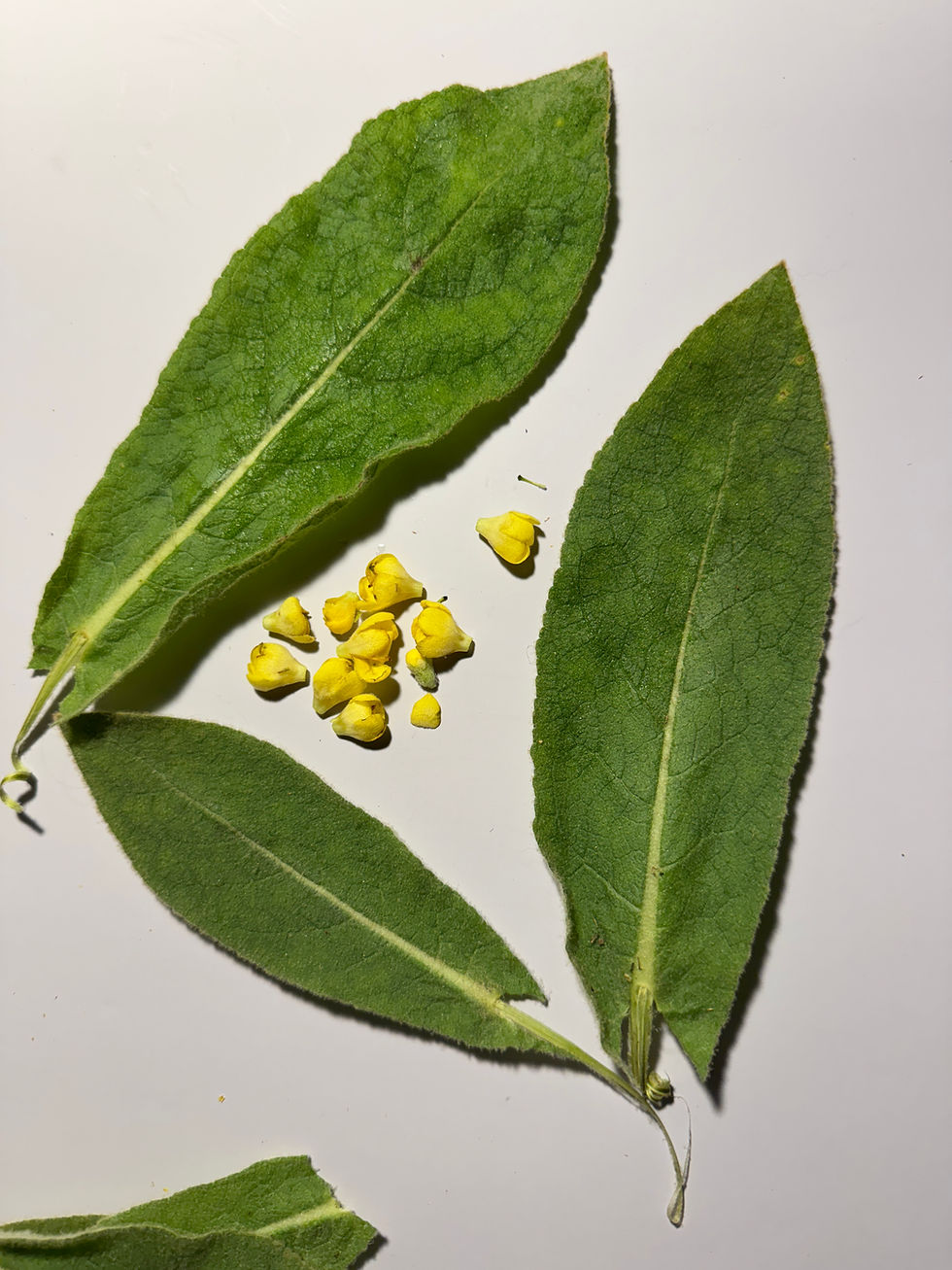Mullein (Verbascum thapsus)
- Christie Merrill
- 6 days ago
- 4 min read

You have probably seen this beauty on roadsides standing tall with it's long stalk of yellow flowers during mid summer. Some common names for mullein include lungwort, velvet plant, hare's beard, Jupiter's staff and old man's flannel. Mullein is a herbaceous biennial, meaning the plant lives for two years. The first year, mullein is a basal rosette of large thick furry leaves. The second year it sends of a tall stalk of yellow flowers, ranging from 2 to 7 feet tall. The yellow flower stalks produce thousands of seeds that can remain viable in soil for up to 100 years. This is why sometimes mullein will pop up seemingly out of nowhere and surprise you with it's presence.

Mullein is a native plant in temperate Europe, northern Africa and western Asia. It is now widespread across North America and the temperate world. It's easy to grow in gardens, it loves sunny areas and thrives in disturbed soils. There are many species of mullein, but the most common we see is called common mullein (Verbascum thapsus) and is the species most commonly used in western herbal medicine.
Identification of common mullein is fairly easy during the second year of growth due to the tall yellow flowering stalks. First year mullein is harder to identify as it has several lookalikes, some of which are poisonous. One plant that looks very similar to mullein in it's basal rosette stage is Foxglove (Digitalis purpurea) which can cause severe bradycardia (slow heart rate) and can lead to death. Foxglove is very common and it is often used as an ornamental for it's beautiful flowers. Before foraging mullein or any wild plant for internal use, be sure to correctly identify using a field guide such as Peterson Field Guide to Medicinal Plants and Herbs or enlist the help of a experienced botanist or herbalist. Staying safe while foraging is of utmost importance, it can mean life and death.

Mullein leaves, roots and flowers can be used medicinally. Mullein leaf is an amazing lung medicine. It works as a gentle tonic that can help to strengthen the lungs and nourish dry lung tissue and decrease inflammation. It is a helpful remedy for those suffering from asthma and chronic lung inflammatory conditions. It's gentle enough to be taken daily, to help protect against respiratory infections during cold and flu season. It can help ease the feeling of a tight chest and wheezing associated with respiratory infections, and can help a ease mild exercise induced asthma (but it is not a substitute for inhalers).

Mullein flowers can be used in cough syrups as an expectorant. The flowers can also be infused in oil as a remedy for ear infections. The infused oil can help to heal the infection and ease the pain. Mullein flowers can also be used as a mild nervine to soothe the nerves when pain is causing anxiety. The flower essence of mullein can assist in easing depression and melancholy and bring light back to one's life. Mullein root is used by modern herbalists as a remedy for spinal ailments, nerve pain and arthritis. It can also be used as medicine for toning and strengthening the bladder.
In Greek legend, mullein was given to Ulysses to protect himself from Circe's magic and was thought to protect against demons and evil spirits in the middle ages. Greeks dried flower stalks and dipped them into fat such as tallow to make torches and lamps. A fun summer project is to make mullein torches by dipping dried flower stalks in beeswax and burning them outdoors.

Harvesting mullein leaves when the flower stalks have formed is an easy way to identify and use mullein's medicine. Cultivating mullein in your garden is the surest way to know the plant and know the conditions in which it grew. Mullein leaves can be used as tea, or as a tincture or decoction. Mullein leaves have small hairs that can irritate the throat so it important to double filter the tea. Brew the leaves into a tea and run through filter twice to make sure filter out the small hairs.

I prefer using mullein in a tincture as it is a convenient way to use it daily during cold and flu season. I make a double extracted tincture to create the most powerful medicine. To make a double extracted mullein tincture using the folk method, crush the fresh leaves and cover with a 150 proof or 75% alcohol. Infuse for 6-8 weeks. After this time strain out the plant material and then repeat the process with dried mullein leaf. Infuse for 6-8 and strain, Put in dropper bottles and use in small doses daily, or several times a day when you are actively fighting off a respiratory infection.

When you see mullein, think of it's gifts. And remember we are walking among medicine.
This blog post is for informational purposes only and is not medical advice. I encourage you to learn as much as you can about this amazing plant.



Comments